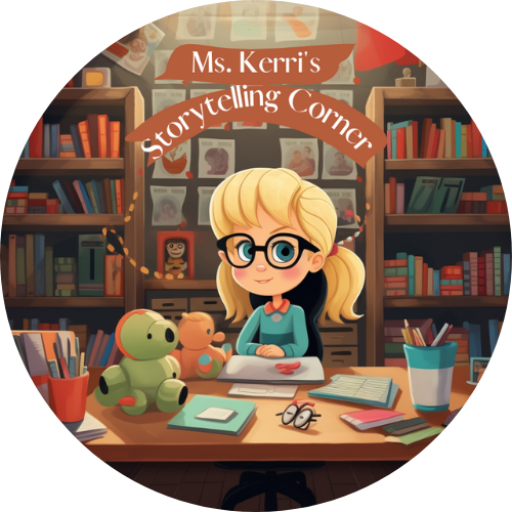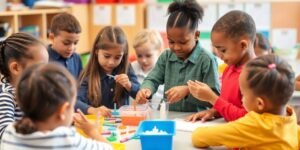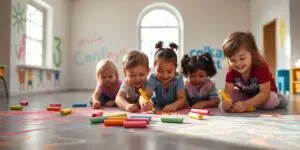The Reggio Emilia approach is a distinctive and highly respected educational philosophy that originated in Italy. It views children as strong, capable learners and emphasizes the importance of social collaboration, project-based learning, and the environment as a key component of the learning process. This article delves into the principles of the Reggio Emilia way and explores how it can be integrated with curriculum standards to create a child-centered learning environment. Additionally, it compares this approach with other educational philosophies and offers practical advice for teachers and parents interested in this method.
Key Takeaways
- The Reggio Emilia approach prioritizes the environment as a ‘third teacher,’ project-based learning, and social collaboration in early childhood education.
- Teachers can integrate Reggio Emilia principles with curriculum standards by balancing playful learning with academic outcomes and designing learning invitations that align with curriculum benchmarks.
- Creating a child-centered learning environment involves recognizing the importance of play in child development and facilitating exploration and experimentation through intentional play-based activities.
- The Reggio Emilia approach differs from traditional, Waldorf, and Montessori educational models, each having unique philosophies about the role of the teacher, the environment, and the child’s learning process.
- For practical application, educators should be qualified and experienced in Reggio-inspired methods, and parents should look for preschools that offer a rich learning environment that encourages curiosity and a love for learning.
Understanding the Reggio Emilia Approach
The Role of the Environment as the Third Teacher
In the Reggio Emilia approach, the environment is more than just a backdrop; it’s an active participant in the learning process. Thoughtfully arranged spaces spark curiosity and foster meaningful interactions. Here, every corner, every material speaks to the child, inviting exploration and discovery.
Educators are not just facilitators; they are designers of these dynamic learning landscapes. They craft environments that are safe, supportive, and rich with possibilities, ensuring that the physical space contributes to a child’s education as much as any lesson plan.
- Safety and Cleanliness: Paramount for fostering trust and freedom to explore.
- Materials: Carefully selected to inspire and challenge.
- Layout: Designed to encourage movement, collaboration, and independence.
The environment in Reggio Emilia is a canvas, where children paint their learning experiences with broad strokes of imagination and inquiry.
Small class sizes and low student-to-teacher ratios are not just numbers; they are the framework that allows for deep, personalized learning experiences. By connecting children with the world, both inside and outside the classroom, we lay the foundation for a lifelong love of learning and an intrinsic understanding of the world around them.
Project-Based Learning as a Core Method
Project-based learning for children is not just an educational buzzword; it’s a dynamic pathway to deeper understanding. By engaging in real-world projects, children develop critical thinking, creativity, and problem-solving skills.
Project-based learning is particularly effective in the Reggio Emilia approach, where the child’s interests fuel the journey of exploration and discovery. Here, learning is not a one-size-fits-all process but a tailored experience that respects each child’s unique path.
- Embracing Curiosity: Children’s natural inquisitiveness is the engine of project-based learning.
- Collaborative Exploration: Working together, children learn from each other, sharing insights and ideas.
- Reflective Process: Regular reflection turns experiences into valuable learning moments.
In the Reggio Emilia classroom, every project is a mosaic of ideas, with each child contributing a piece to the larger picture of understanding.
Teachers play a pivotal role in guiding this educational approach, ensuring that projects are meaningful and aligned with the children’s developmental stages. The result is a vibrant tapestry of learning, woven together by the threads of curiosity, collaboration, and creativity.
Collaboration and Social Interaction in Learning
In the Reggio Emilia approach, fostering collaboration and social interaction is pivotal. Classrooms are purposefully designed to be conducive to cooperative play, with intimate spaces that encourage conversations and teamwork. Small spaces are key to maintaining manageable noise levels while promoting close-knit interactions.
- Active learning involves children in hands-on, authentic activities, with teachers as facilitators.
- Cooperative and collaborative learning group children to complete tasks together, enhancing their social skills.
Through play-based learning, children develop vital social skills: taking turns, sharing, negotiating, and effective communication. These skills lay the foundation for forming positive relationships in the future. It’s essential for teachers to create opportunities for social play, which bolsters emotional development and communication abilities.
By encouraging teamwork, educators play a crucial role in nurturing students’ collaboration and communication skills.
Integrating Reggio Emilia Principles with Curriculum Standards
Balancing Playful Learning with Academic Outcomes
Achieving the sweet spot between playful learning and academic rigor isn’t just possible; it’s a practice that reaps rich rewards. Educators must strike a balance between open-ended exploration and structured teaching to ensure children thrive.
- Open-ended investigation time fosters creativity and critical thinking.
- Explicit teaching lessons target specific academic outcomes.
- A blend of both approaches cultivates a well-rounded educational experience.
Balancing these elements is key to a successful play-based program. It’s about understanding and integrating the curriculum with children’s natural inclination to play and discover.
Finding this equilibrium is not just effective; it’s essential for nurturing academic, social, and emotional growth. It’s a dynamic process that requires educators to be well-versed in curriculum standards, child development, and play-based learning theories.
Adapting Reggio Emilia Concepts to Meet Educational Benchmarks
Marrying the Reggio Emilia approach with academic benchmarks is a dance of creativity and precision. Educators tailor the curriculum, ensuring that each child’s journey through learning is both explorative and aligned with educational standards.
- Identify Core Standards: Start by pinpointing the essential learning outcomes.
- Customize Projects: Design projects that resonate with these outcomes, yet stem from children’s interests.
- Assess Progress: Use observational and documentation strategies to track development.
Embrace flexibility within the structure. The goal is to foster a learning environment where curiosity leads and standards guide.
By integrating Reggio-inspired practices, teachers craft a curriculum that is as dynamic as it is effective. Children thrive when their natural inquisitiveness is the compass for their educational voyage.
Designing Learning Invitations Aligned with Curriculum
Crafting learning invitations that resonate with curriculum standards is a delicate art. Thoughtfully designed invitations spark curiosity and encourage self-paced exploration. For instance, offering a variety of loose parts can inspire children to engage in pattern creation, sorting, or transient art, all while subtly reinforcing academic concepts.
- Understand your curriculum deeply
- Align activities with student interests and developmental stages
- Provide open-ended materials for creative exploration
By intertwining play with curriculum goals, we create a harmonious learning space that respects the child’s developmental journey and academic milestones.
Remember, the goal is to blend play-based activities with explicit teaching moments seamlessly. This approach not only meets developmental needs but also fosters a collaborative atmosphere where students can extend their learning together.
Creating a Child-Centered Learning Environment
The Importance of Play in Child Development
Play is the cornerstone of early learning. It’s the natural way through which children explore the world, understand concepts, and develop essential life skills. Play isn’t just fun; it’s the foundation of early childhood learning.
- Play fosters cognitive growth and creativity.
- It nurtures social and emotional development.
- Physical and language skills are honed during play.
Play-based learning is not a break from learning; it is learning itself. It empowers children to become confident, self-directed learners, building resilience and communication skills.
Incorporating play into daily activities ensures a holistic approach to a child’s development. It’s a joyful, engaging process that supports the intricate tapestry of growth in the early years.
Setting Up Intentional Play-Based Learning Invitations
Intentional play-based learning invitations are a cornerstone of a vibrant classroom. They are the silent guide, leading children through a journey of cognitive learning. By crafting these invitations with care, educators set the stage for meaningful exploration.
Thoughtfully designed learning invitations allow children to explore at their own pace. They are not just activities but a call to engage, question, and create. Here’s how to make them count:
- Align invitations with developmental stages and curriculum goals.
- Provide open-ended materials to foster creativity and problem-solving.
- Encourage collaboration, allowing children to learn from one another.
Use this knowledge to inform your planning, ensuring activities are developmentally suitable and educationally rich.
Remember, the goal is to spark curiosity and a love for learning. With the right setup, children will not only meet curriculum standards but exceed them through their own discoveries.
Facilitating Exploration and Experimentation
Encourage curiosity and foster scientific thinking through hands-on exploration. Children thrive when they can touch, manipulate, and experiment with their surroundings.
- Provide open-ended materials that spark imagination.
- Design activities that integrate play with curriculum goals.
- Cultivate a maker mindset with spaces for creation, such as ateliers or art studios.
By setting up environments that invite discovery, educators empower children to learn through their natural desire to explore.
Balancing freedom with intention, educators can guide children’s explorations to align with educational standards, ensuring that each playful discovery is also a step towards learning objectives.
Comparing Educational Philosophies
Reggio Emilia vs. Traditional Preschool Models
The Reggio Emilia approach and traditional preschool models present distinct paths in early childhood education. Reggio Emilia emphasizes the child as a capable learner, fostering creativity and collaboration, while traditional models often focus on structured curriculum and direct instruction.
Traditional preschools may prioritize academic readiness, with a clear emphasis on skills like alphabet recognition and counting. In contrast, Reggio-inspired settings value the learning process over the product, encouraging exploration and social learning.
- Reggio Emilia: Collaborative, project-based, environment-focused
- Traditional: Structured, skill-focused, teacher-led
The choice between Reggio Emilia and traditional education models hinges on a child’s unique needs and a family’s educational values. It’s not about one being better than the other, but about finding the right fit for each child.
The Intersection of Reggio Emilia and Waldorf Approaches
At the heart of both Reggio Emilia and Waldorf education is a deep respect for the child as a whole being. Both philosophies embrace the child’s creative spirit, fostering a love for learning through different, yet harmonious, practices.
Creativity and imagination are the lifeblood of Waldorf’s approach, seamlessly integrating arts into every aspect of learning. Reggio Emilia, while also valuing creativity, places a stronger emphasis on social collaboration and the environment as a dynamic participant in the learning process.
- Waldorf: Holistic development, arts interwoven with academics
- Reggio Emilia: Child as capable learner, project-based learning
Both approaches share a commitment to nurturing a child’s connection to the world, though they differ in methods and materials.
The practical application of these philosophies can vary widely, but the core values remain constant: honoring the child’s innate curiosity and capacity for learning. As educators and parents weigh their options, understanding these nuances can guide them to a program that resonates with their own educational values.
Contrasting Reggio Emilia and Montessori Methodologies
While both Montessori and Reggio Emilia value child-led learning, they diverge in practice and philosophy. Montessori emphasizes individual learning with a structured environment, whereas Reggio Emilia fosters group projects and a fluid, evolving classroom.
- Montessori: Individual-focused, structured materials, self-paced learning.
- Reggio Emilia: Group collaboration, project-based, environment as teacher.
Both approaches share a respect for the child as an active participant in their own education, yet they apply this principle differently.
Understanding these differences is crucial for educators and parents making informed decisions about early childhood education.
Practical Applications for Teachers and Parents
Qualifications and Experience of Reggio-Inspired Educators
Educators who embrace the Reggio Emilia approach are more than just teachers; they are architects of a child’s foundational years. The right qualifications and experience are crucial in shaping a learning environment that mirrors the Reggio philosophy.
Qualifications matter. Look for educators with degrees in early childhood education, specialized training in the Reggio approach, and a passion for collaborative, child-centered learning. Experience in a Reggio-inspired setting is a bonus, adding depth to their practice.
- Certifications: Early Childhood Education, Reggio Emilia Training
- Skills: Collaboration, Creativity, Observation
- Experience: Hands-on in Reggio Settings
The educator’s role is to facilitate, not dictate, the learning journey. They create a canvas where each child paints their own understanding of the world.
Selecting the right educator is a partnership decision. Parents should engage in conversations about classroom management, student engagement, and the teacher’s vision for honoring each child’s unique path.
Incorporating Play-Based Activities in Structured Lessons
Blending preschool activities with structured lessons bridges the gap between play and learning. Direct instruction anchors the curriculum, while play-based strategies enrich the experience. For instance, math concepts turn into games, and science experiments become a hands-on affair.
Balancing playful learning with academic outcomes isn’t just possible; it’s highly effective.
To ensure children reap the full benefits of play-based learning—problem-solving, creativity, and social skills—educators must integrate these activities thoughtfully. Here’s a simple guide:
- Use games to teach specific skills and knowledge.
- Set up experiments to make science interactive.
- Offer STEM activities to spark curiosity.
- Employ puppets for language development.
Remember, the goal is to foster academic, social, and emotional growth through a curriculum that’s both playful and purposeful.
Choosing the Right Preschool: What Parents Should Look For
Embarking on the preschool selection journey? Consider your child’s individuality—temperament, social skills, and independence are key. Aligning with a preschool that matches your child’s unique traits is the first step to a fulfilling educational experience.
When evaluating potential preschools, focus on the essentials: location, logistics, curriculum, and educational approach. These factors will greatly influence your child’s daily life and learning.
Here’s a quick checklist to guide you:
- Proximity to home or work for easy drop-offs and pick-ups
- School hours that fit your family’s schedule
- A curriculum that complements your child’s learning style
- A nurturing environment that fosters curiosity and growth
Lastly, don’t underestimate the importance of teacher qualifications and experience. A passionate and knowledgeable educator can make all the difference in your child’s preschool years.
Discover a world of educational resources and engaging activities tailored for young learners at Ms. Kerri’s Story Telling Corner. Whether you’re a teacher looking to inspire your classroom or a parent aiming to foster a love for learning at home, our website is brimming with creative ideas to support children’s development. From interactive storytime sessions to downloadable early learning resources, we have everything you need to spark imagination and curiosity. Don’t miss out on our expert tips and personalized services designed to enrich your child’s educational journey. Visit us now and take the first step towards cultivating a passion for learning in your children!
Embracing the Reggio Emilia Approach in Project-Based Learning
In conclusion, the Reggio Emilia approach to project-based learning offers a transformative educational experience that honors the innate curiosity and capabilities of children. By viewing the environment as an integral teacher, fostering social collaboration, and emphasizing the importance of play, educators can create a rich learning landscape that aligns with children’s developmental stages and nurtures a lifelong love for learning. As we reflect on the principles and practices of this approach, it becomes clear that the Reggio Emilia way is not just about teaching children, but about inspiring a community of learners who are empowered to explore, create, and contribute meaningfully to their world. For educators and parents alike, embracing this philosophy means committing to an educational journey that is as rewarding as it is enlightening, and one that holds the promise of shaping a brighter future for all children.
Frequently Asked Questions
What is the Reggio Emilia approach?
The Reggio Emilia approach is an educational philosophy that originated in Italy, emphasizing the child as a strong, capable learner. It focuses on collaborative, project-based learning, with the environment acting as the third teacher, and values social collaboration.
How does Reggio Emilia compare to traditional preschool models?
Traditional preschools often have a more structured curriculum with direct instruction, while Reggio Emilia encourages project-based learning and values the environment as an integral part of education, fostering social collaboration and self-directed learning.
Can Reggio Emilia principles be integrated with curriculum standards?
Yes, Reggio Emilia principles can be adapted to meet educational benchmarks and standards-based assessments, such as the Australian curriculum. Teachers can balance playful learning with academic outcomes at their discretion.
What role does play have in the Reggio Emilia approach?
Play is central to the Reggio Emilia approach, being a child-centered, age-appropriate pedagogy that fosters creativity, social interaction, academic skills, and critical thinking. It’s seen as vital for a child’s development.
How can teachers create a child-centered learning environment?
Teachers can create a child-centered learning environment by setting up intentional play-based learning invitations that align with the child’s developmental stage and the curriculum, fostering exploration and collaboration among students.
What should parents look for in a Reggio-inspired preschool?
Parents should look for preschools that offer a rich learning environment that encourages curiosity and a love for learning, with a balanced array of activities for cognitive, social, and physical development, and qualified, experienced educators.


Ms. Kerri’s Corner provides a exciting virtual space for preschool learning. Through a variety of engaging activities, she exposes young minds to early math, literacy, science and social-emotional skills in a developmentally appropriate way. Centers for blocks, art, books and music allow children to explore hands-on learning at their own pace. Guided lessons subtly introduce number sense, letter sounds and narrative thinking. Careful observation gives insight into each child’s progress across domains. Viewers are also invited to participate, reinforcing that their ideas are valued. By making learning fun yet purposeful, Ms. Kerri lays the groundwork for future academic success while fostering creativity and imagination. Her program offers preschoolers valuable screen-based learning experiences.









